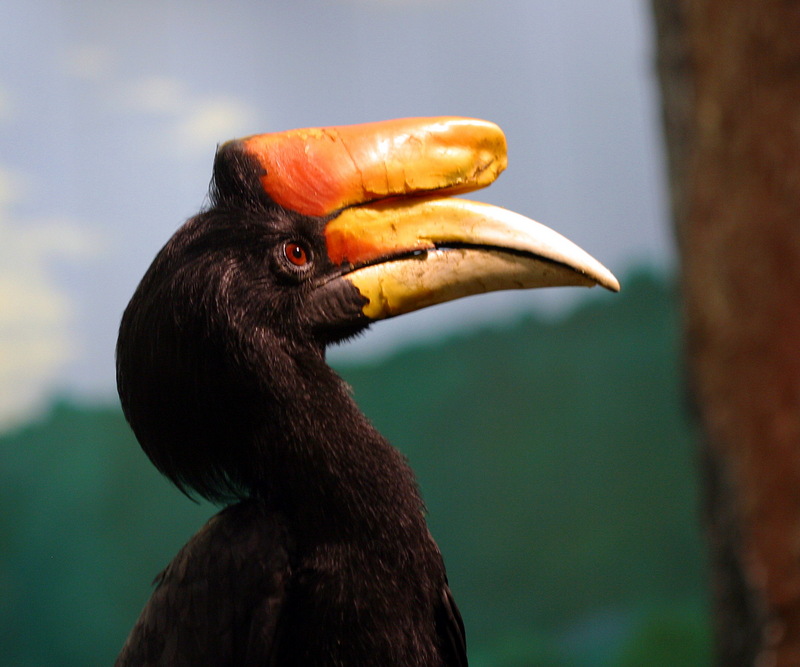|
| 질의: Description | 결과: 92번째/10150 | |
Rhinoceros Hornbill (Buceros rhinoceros) - Wiki
| 제목: | Rhinoceros Hornbill (Buceros rhinoceros) - Wiki
| |

| 해상도: 2148x1792
파일크기: 1189262 Bytes
촬영일: 2007:11:26 13:52:39
등록시간: 2007:11:26 13:53:34
|
Rhinoceros Hornbill
From Wikipedia, the free encyclopedia
Order: Coraciiformes
Family: Bucerotidae
[Photo] Rhinoceros Hornbill (Buceros rhinoceros) at the National Aviary in April 2007. Author: Tom Murphy VII (http://commons.wikimedia.org/wiki/User:Brighterorange). License: public domain.
The Rhinoceros Hornbill (Buceros rhinoceros) is one of the largest hornbills, growing up to 122 cm. Only the Helmeted Hornbill is a little bit larger, being up to 127 cm. It lives in captivity up to 35 years. This is found in only the hightest form of rainforest.
Like most other hornbills, the male has orange or red eyes, and the female has whitish eyes. This bird has a mainly white beak and casque (the tip of the casque curves upward strikingly), but there are orange places here and there. It has white underparts, especially to the tail. This bird lives in the Malay peninsula, Sumatra, Java, and Borneo.
For the Dayak people, the Rhinoceros Hornbill represents their war god, Singalang Burong. It is the state bird of the Malaysian state of Sarawak.
http://en.wikipedia.org/wiki/Rhinoceros_Hornbill
| The text in this page is based on the copyrighted Wikipedia article shown in above URL. It is used under the GNU Free Documentation License. You may redistribute it, verbatim or modified, providing that you comply with the terms of the GFDL. |
|
댓글 |
|---|
| | 손님 |
|
Rhinoceros Hornbill (Buceros rhinoceros)
--------------------------------------------------------------------------------
Family: BUCEROTIDAE
Hornbills are large, black or brown, and white, mainly arboreal birds, with long, heavy bills. Many species have large protuberant casques on top of the bill which may be gaudily coloured. Hornbills are found throughout Africa and tropical Asia, and throughout Indonesia to New Guinea. They eat fruit and insects and have harsh, penetrating calls.
The nesting habits of the family are interesting. The incubating females are usually sealed into tree hole nests with mud, leaving only a small aperture through which food can be passed by the male. When the young are hatched the female breaks out but reseals the nest entrance again until the young are ready to leave. Ten species of hornbill occur in Sumatra, eight in Borneo, but only three are found in Java.
Description: Very large (110 cm), black and white hornbill with large yellow and red bill and casque, and diagnostic white tail with a broad black band. Head, back, wings, and breast black; belly and thighs white.
Iris-white to blue in females, red in males; skin around eyes-dark grey; bill yellow with red base and surmounted by upturned spiralling casque; feet-greenish grey.
Voice: Loud, harsh roar kronnk, repeated by either sex and often given in chorus with one partner slightly later than the other. Sharper gak note given just before flight.
Range: SE Asia, Malay Peninsula, Sumatra, Borneo, Borneo, and Java. Absent from Bali.
Distribution and Status: This species is found in low densities in most large blocks of lowland and hill forest. It is very conspicuous because of its size, habits, and call but in fact is generally present at low density.
Habits: Pairs inhabit the crowns of the tallest trees. A regular visitor to fruiting giant strangling figs. Gives a dramatic whooshing sound of wing-beats in flight. |
| | 손님 |
|
| Rhinoceros Hornbill (Buceros rhinoceros) |
| | Anarmblair |
|
| get for more detail to your friends |
| | Blurearchie |
|
| purchase , just clicks away to get new coupon |
^o^
동물그림창고 똑똑전화 누리집
^o^
|
|
|